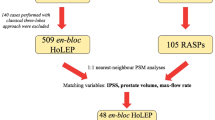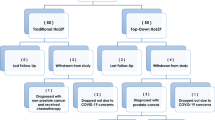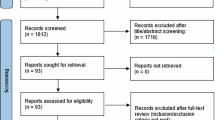Abstract
Background
Machine learning (ML) and artificial intelligence (AI) have demonstrated powerful functionality in the healthcare setting thus far. We aimed to construct an AI model to predict postoperative incontinence after enucleation surgery for benign prostatic hyperplasia (BPH).
Methods
Data were taken from two BPH registries and split into training and validation datasets. The following characteristics were used as predictors of incontinence: age, prostate volume, preoperative IPSS, QoL score, Qmax and post-void residual; presence of preoperative indwelling catheter, early apical release (EAR), enucleation type (2-lobe, 3-lobe, or en-bloc), and laser energy type. Six types of ML models were constructed using the training dataset and applied to the validation dataset to assess their accuracy.
Results
3828 patients from both databases were analyzed. Median age was 68, median prostate volume was 85.5 cc. 5.4% had a preoperative indwelling catheter. The commonest enucleation type was 2-lobe, the commonest energy type was Thulium fiber laser, and EAR was performed in 34.0%. Of the six ML models tested, extreme gradient boosting with manual fine tuning was the best-performing with an accuracy of 86.2%, sensitivity of 96.8%, specificity of 23.7%, PPV of 88.2%, and NPV of 55.9%.
Conclusions
We hereby present an ML model for incontinence prediction post-surgery for BPH. Its main strengths are high sensitivity and PPV, meaning that if a patient is predicted to be incontinent using this model, this is likely to reflect the eventual outcome. This allows clinicians to pay closer attention on follow-up to detect and manage postoperative incontinence expediently.
This is a preview of subscription content, access via your institution
Access options
Subscribe to this journal
Receive 4 print issues and online access
$259.00 per year
only $64.75 per issue
Buy this article
- Purchase on SpringerLink
- Instant access to full article PDF
Prices may be subject to local taxes which are calculated during checkout


Similar content being viewed by others
Data availability
The data that support the findings of this study are available from the corresponding author, K.Y.F., upon reasonable request.
References
Schwalbe N, Wahl B. Artificial intelligence and the future of global health. Lancet. 2020;395:1579–86.
Nagendran M, Chen Y, Lovejoy CA, Gordon AC, Komorowski M, Harvey H, et al. Artificial intelligence versus clinicians: systematic review of design, reporting standards, and claims of deep learning studies. BMJ. 2020;368:m689.
Chen J, Remulla D, Nguyen JH, Dua A, Liu Y, Dasgupta P, et al. Current status of artificial intelligence applications in urology and their potential to influence clinical practice. BJU Int. 2019;124:567–77.
Shah M, Naik N, Somani BK, Hameed BMZ. Artificial intelligence (AI) in urology-Current use and future directions: An iTRUE study. Turk J Urol. 2020;46:S27–s39.
Li J, Chong TW, Fong KY, Han BLJ, Tan SY, Mui JTS, et al. Will artificial intelligence (AI) replace cytopathologists: a scoping review of current applications and evidence of A.I. in urine cytology. World J Urol. 2025;43:200.
Castellani D, De Stefano V, Brocca C, Mazzon G, Celia A, Bosio A, et al. The infection post flexible UreteroreNoscopy (I-FUN) predictive model based on machine learning: a new clinical tool to assess the risk of sepsis post retrograde intrarenal surgery for kidney stone disease. World J Urol. 2024;42:612.
Magistro G, Schott M, Keller P, Tamalunas A, Atzler M, Stief CG, et al. Enucleation vs. Resection: A Matched-pair Analysis of TURP, HoLEP and Bipolar TUEP in Medium-sized Prostates. Urology. 2021;154:221–6.
Castellani D, Rubilotta E, Fabiani A, Maggi M, Wroclawski ML, Teoh JY-C, et al. Correlation Between Transurethral Interventions and Their Influence on Type and Duration of Postoperative Urinary Incontinence: Results from a Systematic Review and Meta-Analysis of Comparative Studies. J Endourol. 2022;36:1331–47.
Hout M, Gurayah A, Arbelaez MCS, Blachman-Braun R, Shah K, Herrmann TRW, et al. Incidence and risk factors for postoperative urinary incontinence after various prostate enucleation procedures: systemic review and meta-analysis of PubMed literature from 2000 to 2021. World J Urol. 2022;40:2731–45.
Gauhar V, Castellani D, Herrmann TRW, Gökce MI, Fong KY, Gadzhiev N, et al. Incidence of complications and urinary incontinence following endoscopic enucleation of the prostate in men with a prostate volume of 80 ml and above: results from a multicenter, real-world experience of 2512 patients. World J Urol. 2024;42:180.
Gauhar V, Gómez Sancha F, Enikeev D, Sofer M, Fong KY, Rodríguez Socarrás M, et al. Results from a global multicenter registry of 6193 patients to refine endoscopic anatomical enucleation of the prostate (REAP) by evaluating trends and outcomes and nuances of prostate enucleation in a real-world setting. World J Urol. 2023;41:3033–40.
Rokach L. Ensemble-based classifiers. Artificial Intell Rev. 2010;33:1–39.
Langenberger B, Schulte T, Groene O. The application of machine learning to predict high-cost patients: A performance-comparison of different models using healthcare claims data. PLoS ONE. 2023;18:e0279540.
Luu BC, Wright AL, Haeberle HS, Karnuta JM, Schickendantz MS, Makhni EC, et al. Machine Learning Outperforms Logistic Regression Analysis to Predict Next-Season NHL Player Injury: An Analysis of 2322 Players From 2007 to 2017. Orthop J Sports Med. 2020;8:2325967120953404.
Hong W, Zhou X, Jin S, Lu Y, Pan J, Lin Q, et al. A Comparison of XGBoost, Random Forest, and Nomograph for the Prediction of Disease Severity in Patients With COVID-19 Pneumonia: Implications of Cytokine and Immune Cell Profile. Frontiers Cell Infect Microbiol. 2022;12:2022.
Khalilia M, Chakraborty S, Popescu M. Predicting disease risks from highly imbalanced data using random forest. BMC Med Inform Decis Mak. 2011;11:51.
Houssin V, Olivier J, Brenier M, Pierache A, Laniado M, Mouton M, et al. Predictive factors of urinary incontinence after holmium laser enucleation of the prostate: a multicentric evaluation. World J Urol. 2021;39:143–8.
Cornwell LB, Smith GE, Paonessa JE. Predictors of Postoperative Urinary Incontinence After Holmium Laser Enucleation of the Prostate: 12 Months Follow-Up. Urology. 2019;124:213–7.
Herrin J, Abraham NS, Yao X, Noseworthy PA, Inselman J, Shah ND, et al. Comparative effectiveness of machine learning approaches for predicting gastrointestinal bleeds in patients receiving antithrombotic treatment. JAMA Netw Open. 2021;4:e2110703-e.
Wang F. Machine learning for predicting rare clinical outcomes—finding needles in a haystack. JAMA Netw Open. 2021;4:e2110738-e.
Saraswat D, Bhattacharya P, Verma A, Prasad VK, Tanwar S, Sharma G, et al. Explainable AI for Healthcare 5.0: Opportunities and Challenges. IEEE Access. 2022;10:84486–517.
Author information
Authors and Affiliations
Contributions
KYF: Methodology, Software, Formal Analysis, Investigation, Data Curation, Writing – Original Draft, Visualization. VG: Conceptualization, Methodology, Investigation, Writing – Original Draft, Writing – Review & Editing, Project Administration. TRWH: Methodology, Investigation, Writing – Review & Editing. CN: Methodology, Investigation, Writing – Review & Editing. DE: Conceptualization, Methodology, Investigation, Writing – Review & Editing. JCYT: Methodology, Investigation, Writing – Review & Editing. SB: Methodology, Investigation, Writing – Review & Editing. SKKY: Conceptualization, Methodology, Investigation, Writing – Original Draft, Writing – Review & Editing, Project Administration. DC: Conceptualization, Methodology, Investigation, Writing – Original Draft, Writing – Review & Editing, Project Administration. BKS: Methodology, Investigation, Writing – Review & Editing, Supervision. PJJ: Methodology, Investigation, Writing – Review & Editing. VHLG: Methodology, Investigation, Writing – Review & Editing, Supervision. EJA: Methodology, Investigation, Writing – Review & Editing. EJL: Conceptualization, Methodology, Investigation, Writing – Original Draft, Supervision, Project Administration.
Corresponding author
Ethics declarations
Ethics approval and consent to participate
(a) All methods were performed in accordance with the relevant guidelines and regulations. (b) Approval has been obtained from a named ethics committee: Asian Institute of Nephrology and Urology, AINU #11/2022. (c) Informed consent was obtained from all participants.
Competing interests
The authors declare no competing interests.
Additional information
Publisher’s note Springer Nature remains neutral with regard to jurisdictional claims in published maps and institutional affiliations.
Rights and permissions
Springer Nature or its licensor (e.g. a society or other partner) holds exclusive rights to this article under a publishing agreement with the author(s) or other rightsholder(s); author self-archiving of the accepted manuscript version of this article is solely governed by the terms of such publishing agreement and applicable law.
About this article
Cite this article
Fong, K.Y., Gauhar, V., Herrmann, T.R.W. et al. Machine learning models to predict postoperative incontinence after endoscopic enucleation of the prostate for benign prostatic hyperplasia: An EAU-Endourology study. Prostate Cancer Prostatic Dis (2025). https://doi.org/10.1038/s41391-025-01015-1
Received:
Revised:
Accepted:
Published:
DOI: https://doi.org/10.1038/s41391-025-01015-1



